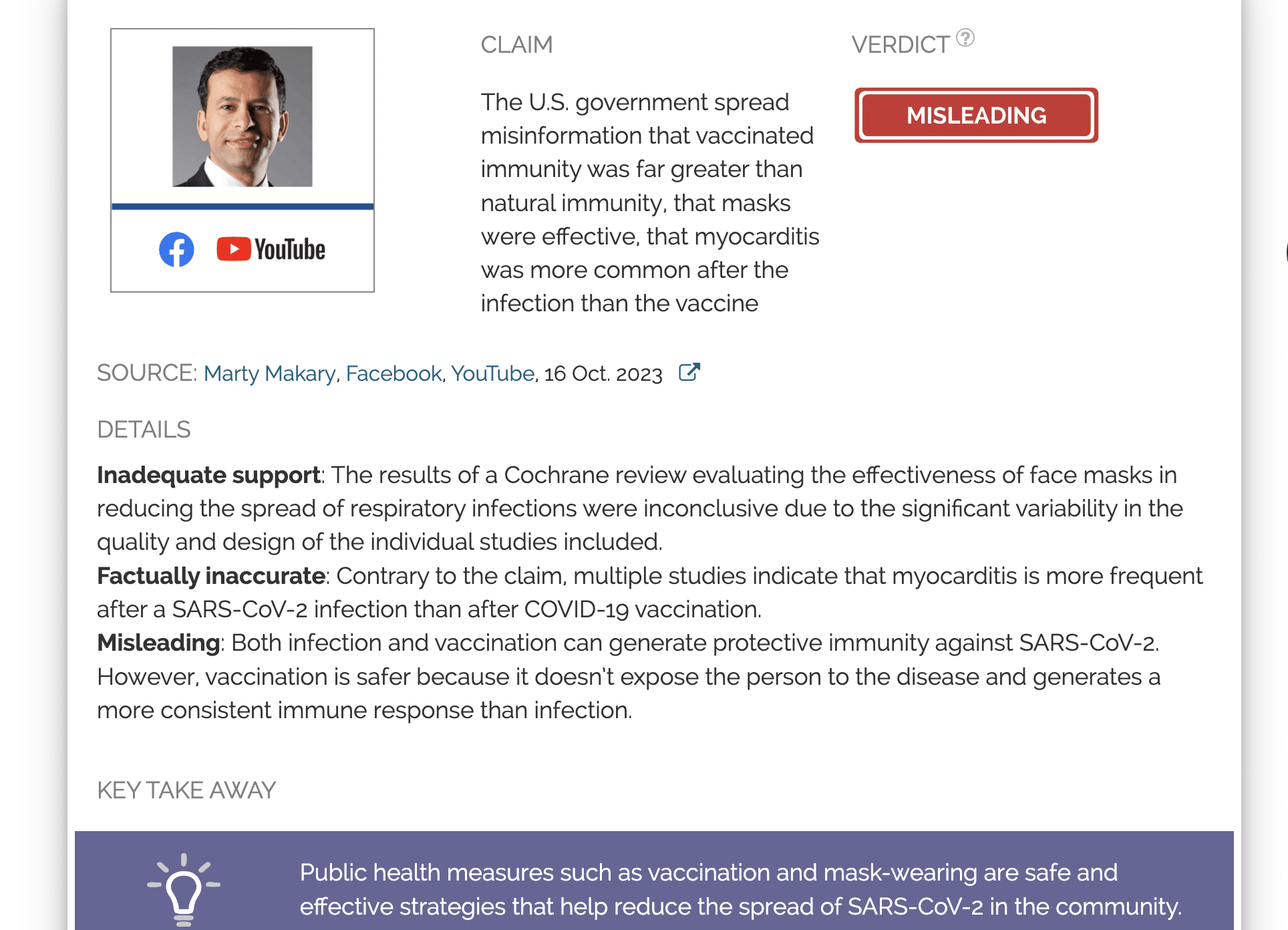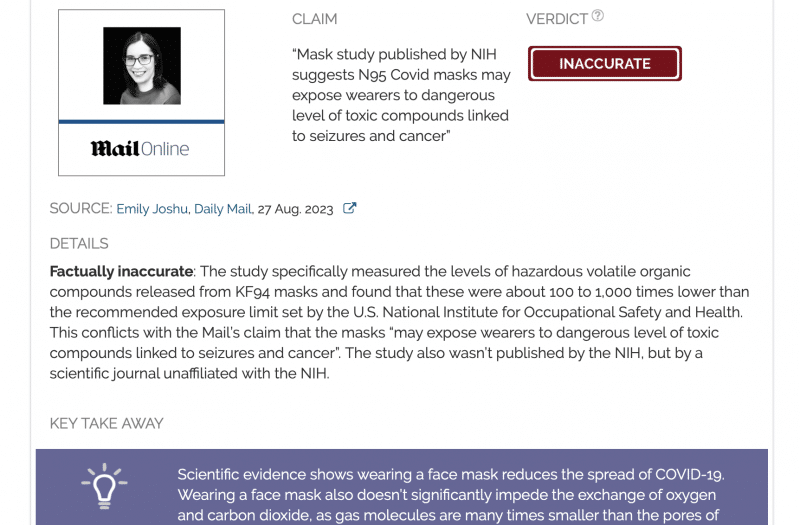- Health
Telegraph article describing the hypothesis that face masks can variolate a population receives mixed reviews on its scientific accuracy
Scientists’ Feedback
SUMMARY
This article by The Telegraph, published on 12 September 2020, describes a Perspective article published in the New England Journal of Medicine (NEJM)[1]. The NEJM article presents the hypothesis that wearing face masks for COVID-19 offers other benefits, apart from reducing virus transmission, specifically in reducing the severity of COVID-19 and ensuring that a greater proportion of new infections are asymptomatic.
According to this hypothesis, wearing face masks can reduce the amount of virus that a susceptible person comes into contact with, leading to less severe disease if the person does become infected. Such mild infections are less likely to result in death and complications, while inducing immunity to the disease at the same time. The authors compare this to the practice of variolation, which was performed before the smallpox vaccine was developed.
According to the U.S. National Library of Medicine, variolation is a “deliberate infection with smallpox”:
“Dried smallpox scabs were blown into the nose of an individual who then contracted a mild form of the disease. Upon recovery, the individual was immune to smallpox. Between 1% to 2% of those variolated died as compared to 30% who died when they contracted the disease naturally.”
Scientists who reviewed the Telegraph article found some aspects were accurate, particularly the representation of the NEJM article. Dale Fisher, an infectious disease expert and a professor of medicine at the National University of Singapore, said, “the article is essentially true to the NEJM commentary.”
Likewise, Jason Kindrachuk, a virologist and assistant professor at the University of Manitoba, found that the article “provides a cogent and accurate summary of the recent Perspective article from Gandhi and Rutherford. The author of the article provides direct commentary from the NEJM piece without overstating much of the information that was originally presented.”
However, reviewers also pointed out that the article contains some inaccuracies and potentially misleading and imprecise statements, particularly the article’s headline.
“Masks don’t give immunity; rather, the argument is that infections are milder or asymptomatic and allow immunity without severe disease,” Fisher explained. In other words, masks do not automatically confer immunity to the wearer. This immunity would arise only in the event that the wearer becomes infected.
Rasha Msallam, a senior research fellow at Duke-NUS Medical School, also concurred, finding that the article does not clearly distinguish between immunization—a procedure by which a person is made immune to a disease, typically with a vaccine—and the concept of variolation. In the case of variolation, a person would still develop the disease, although they are more likely to have it in a milder form, which carries less risk. Unlike variolation, vaccine-induced immunity does not need to induce the disease to generate immunity and is therefore safer.
The article could also have provided more information to explain that infectious dose (the initial amount of virus that sets off the infection) is not always indicative of a person’s viral load (the total amount of virus in an infected person) and disease severity. “Viral load at diagnosis may be determined by a myriad of factors, including the initial amount of virus delivered at the time of infection,” Kindrachuk pointed out. “There are few studies that have investigated titrations of viral loads in animal models, so our understanding of infectious dose remains fairly unclear.”
William Hanage, an associate professor of epidemiology at the Harvard T.H. Chan School of Public Health, cautioned that there is still no evidence demonstrating that masks can variolate a population. “There is evidence from other infections that challenge with very small infectious doses can build immunity more safely, but this is not the case for SARS-CoV-2 nor is there evidence that it can be achieved by mask use,” he explained.
In conclusion, the Telegraph article is accurate in its representation of the original NEJM article, but could mislead readers due to lack of context, especially with its headline. While wearing face masks is an important public health measure for reducing virus transmission for COVID-19, they do not provide complete protection alone and must be combined with other practices such as physical distancing and regular hand washing. Although an interesting concept, the hypothesis that masks can reduce the severity of COVID-19 and facilitate the development of immunity for those that wear them is currently not supported by scientific evidence.
You can read the original Telegraph article here.
REVIEWERS’ OVERALL FEEDBACK:

Professor (Department of Medicine), National University of Singapore
The Telegraph headline is obviously misleading but the subheading is accurate. Masks don’t give immunity; rather, the argument is that infections are milder or asymptomatic and allow immunity without severe disease. The article is essentially true to the NEJM commentary, however a reader could become confused and think that the article suggests masks give you COVID-19 immunity.

Senior Research Fellow, Duke-NUS Medical School
The title of the Telegraph article is misleading. In the NEJM article, the authors suggested that wearing a mask reduces the exposure to the viral load, but they didn’t confirm or mention the development of immunity to COVID-19.
The implication in the Telegraph article that wearing a mask is a type of immunization or inoculation is completely wrong. It appears to confuse the definition of immunization and the concept of reducing risk factor to exposure to viral particles through variolation.
Finally, it is important to keep in mind that the NEJM article didn’t confirm that wearing masks is THE solution. Rather, the authors suggested that this social behavior might help to reduce the mortality rate of the infection as we wait for the most efficient vaccine(s) against COVID-19.

Associate Professor of Epidemiology, Harvard T. H. Chan School of Public Health
There’s no evidence that masks have the alleged properties. There is evidence from other infections that challenge with very small infectious doses can build immunity more safely, but this is not the case for SARS-CoV-2 nor is there evidence that it can be achieved by mask use.

Assistant Professor, Rady Faculty of Health Sciences, University of Manitoba
Overall, the article from The Telegraph provides a cogent and accurate summary of the recent Perspective article from Gandhi and Rutherford. The author of the article provides direct commentary from the NEJM piece without overstating much of the information that was originally presented.
One potential limitation was the statement that this was an “unproven but promising theory.” While it could be stated that the authors believe that this is a promising theory that may hold water, there is a slight implication that overall this is considered a promising theory, which cannot yet be stated.
In regard to the discussion on infectious dose, it should be mentioned that the link between viral load at diagnosis and mortality is not necessarily indicative of the original infectious dose, given that viral load at diagnosis may be determined by a myriad of factors, including the initial amount of virus delivered at the time of infection. There are few studies that have investigated titrations of viral loads in animal models, so our understanding of infectious dose remains fairly unclear. This is perhaps unsurprising as the infectious dose for SARS-CoV, the etiologic agent of SARS, is theorized to be on the order of hundreds to thousands of viral particles but has yet to be definitively established.
Annotations
The statements quoted below are from the article; comments are from the reviewers (and are lightly edited for clarity).
“The commentary, published in the New England Journal of Medicine, advances the unproven but promising theory that universal face mask wearing might be helping to reduce the severity of the virus and ensuring that a greater proportion of new infections are asymptomatic.”

Assistant Professor, Rady Faculty of Health Sciences, University of Manitoba
While it could be stated that the authors believe that this is a promising theory that may hold water, there is a slight implication that overall this is considered a promising theory, which cannot yet be stated.
“This is because even a low viral load can be enough to induce an immune response, which is effectively what a typical vaccine does.”

Associate Professor of Epidemiology, Harvard T. H. Chan School of Public Health
This misrepresents how vaccines work. They are not low doses of pathogens.
“It comes as increasing evidence suggests that the amount of virus someone is exposed to at the start of infection – the ‘infectious dose’ – may determine the severity of their illness. Indeed, a large study published in the Lancet last month found that ‘viral load at diagnosis’ was an ‘independent predictor of mortality’ in hospital patients.”

Assistant Professor, Rady Faculty of Health Sciences, University of Manitoba
It should be mentioned that the link between viral load at diagnosis and mortality is not necessarily indicative of the original infectious dose, given that viral load at diagnosis may be determined by a myriad of factors, including the initial amount of virus delivered at the time of infection. There are few studies that have investigated titrations of viral loads in animal models, so our understanding of infectious dose remains fairly unclear. This is perhaps unsurprising as the infectious dose for SARS-CoV, the etiologic agent of SARS, is theorized to be on the order of hundreds to thousands of viral particles but has yet to be definitively established.
REFERENCES
- 1 – Gandhi and Rutherford. (2020) Facial Masking for Covid-19 — Potential for “Variolation” as We Await a Vaccine. New England Journal of Medicine.



